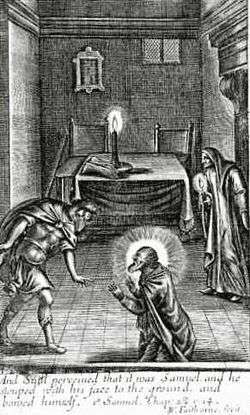Saducismus Triumphatus

Saducismus triumphatus[1] is a book on witchcraft by Joseph Glanvill, published posthumously in England in 1681.
The editor is presumed to have been Henry More, who certainly contributed to the volume;[2] and topical material on witchcraft in Sweden was supplied by Anthony Horneck to later editions. By 1683 this appeared as a lengthy appendix.[3] Horneck's contribution came from a Dutch pamphlet of 1670.[4][5]
The book affirmed the existence of witches with malign supernatural powers of magic, and attacked skepticism concerning their abilities. Glanvill likened these skeptics to the Sadducees, members of a Jewish sect from around the time of Jesus who were said to have denied the immortality of the soul. The book is also noted for the account of the Drummer of Tedworth, an early poltergeist story, and for one of the earliest descriptions of the use of a witch bottle, a countercharm against witchcraft.
Influence

The book strongly influenced Cotton Mather in his Discourse on Witchcraft (1689) and the Salem witch trials held 1692-3 in Salem, Massachusetts. Mather's Wonders of the Invisible World (1693) is largely modeled after this book and its reports, particularly the material relating to the Mora witch trial of 1669.[4] The book is cited by H. P. Lovecraft in his short story The Festival
See also
Notes
- ↑ Saducismus triumphatus: or, Full and plain evidence concerning witches and apparitions. In two parts. The first treating of their possibility. The second of their real existence.
- ↑
 "More, Henry (1614-1687)". Dictionary of National Biography. London: Smith, Elder & Co. 1885–1900.
"More, Henry (1614-1687)". Dictionary of National Biography. London: Smith, Elder & Co. 1885–1900. - ↑
 "Horneck, Anthony". Dictionary of National Biography. London: Smith, Elder & Co. 1885–1900.
"Horneck, Anthony". Dictionary of National Biography. London: Smith, Elder & Co. 1885–1900. - 1 2 Ankarloo, Bengt and Henningsen, Gustav (editors) Early Modern European Witchcraft: Centres and Peripheries (1990). Oxford: Oxford University Press. p. 431-3.
- ↑ The full-title of the 1682 An account of what happen'd in the kingdom of Sweden in the years 1669, and 1670 and upwards. In relation to some persons that were accused for witches; and tryed and executed by the Kings command. Together with the particulars of a very sad accident that befel a boy at Malmoe in Schonen in the year, 1678. by the means of witchcraft, attested by the ablest and most judicious men of that town. Both translated out of High-Dutch into English, By Anthony Horneck D.D says High Dutch, however, i.e. in German.
External links
- Graphical reproduction of Sadducismus Triumphatus at the University of Pennsylvania library.
- Sadducismus Triumphatus at the Internet Archive.